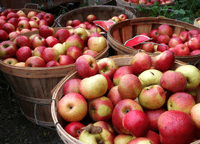
The organic industry is hot; it’s the fastest growing sector of the supermarket, increasing in sales from $3.6 billion to $24.4 billion between the years of 1997 to 2011. The topic of organic foods has received even more attention recently in response to a study released from Stanford University in September 2012, which concluded that there isn’t much difference between organic and conventional foods.
The study set off a firestorm of dialogue among both consumers and nutrition professionals, as they discussed a larger meaning of whether choosing organic foods is the best strategy for your health, as well as for the environment.
DEBATE ON NUTRITIONAL PAYBACK
The Stanford researchers reviewed a collection of about 240 previously published studies, developing a statistical compilation of these findings. The studies they examined were performed over multiple years and took into account the nutrient and bacterial, fungal, or pesticide contamination levels in various foods, such as fruits, vegetables, grains, meats, milk, poultry, and eggs, as well as its impact on humans.
The study stated that for most vitamins and minerals, no significant difference between organic and conventional produce was found in nutrient content, with the exception of phosphorous, which was higher in organically grown varieties. Yet, researchers did find organic produce to have a 30 percent lower risk of pesticide contamination, and organically farmed chicken and pork to have lower levels of antibiotic-resistant bacteria.
Despite these findings, other studies have documented health and environmental advantages of organic foods compared to their conventional counterparts. A similar analysis of studies conducted by researchers at Newcastle University in England found higher levels of vitamin C and phenols (plant antioxidants) in organically grown crops.
In a study published in the March 2012 issue of the Journal of Agricultural and Food Chemistry, which examined the effects of organic and conventional cropping systems for spinach, researchers found the organic variety to have higher levels of certain flavonoids and vitamin C.
BEYOND NUTRITION
One of the main attractions for eating organic goes beyond increased nutrient content to lowering one’s exposure to pesticide residues.
“Don’t buy organics to increase phytochemical intake, but (buy them) because organics generally have lower levels of pesticides,” urges Alyson Mitchell, Ph.D., professor and food chemist at the University of California-Davis.
A study published in Environmental Health Perspectives detailed a dramatic and immediate protective effect against exposure to pesticides among 23 elementary school children who participated. They were fed organic food items as substitutes for the conventional foods in their diet.
“Although the FDA assures that pesticide residue on individual food samples are within safe limits, what we do not know is how that cumulative load of organophosphorous pesticides affects children, pregnant and breastfeeding women and seniors,” says Angie Tagtow, M.S.. R.D., L.D., dietitian and owner of Environmental Nutrition Solutions, LLC, a company that focuses on environmental approaches to food and nutrition.
 IMPACT ON MOTHER EARTH
IMPACT ON MOTHER EARTH
The organic food movement also takes into consideration how agricultural practices affect the environment. The Rodale Institute’s Farming Systems Trial is the longest-running U.S. study to compare conventional and organic agricultural practices. The project found that organic farming uses 45 percent less energy, produces 40 percent less greenhouse gas emissions, and better supports soil organic matter compared to conventional systems.
Additional evidence-based studies indicate organic farming methods create healthy soils, which yield crops that are consistent with, or better than, those grown by conventional agricultural methods.
ORGANIC FOOD CONSIDERATIONS
1. Fruits and vegetables. When it comes to eating your daily quota of fruits and vegetables, it may be best to start at square one by simply focusing on increasing your daily intake. According to a 2010 report released by the National Fruit and Vegetable Alliance, only six percent of people are eating enough vegetables and only eight percent are eating enough fruit each day.
2. Junk foods. When health is a priority, it’s important to keep in mind the type of food eaten, not just the farming or production method it undergoes.
Spending your money on low-nutrient organic junk foods, such as cookies, chips and sugary beverages is not the best use of your organic dollars.
3. Dairy. Because of organic regulations, organic dairy farmers are prohibited from using antibiotics or synthetic hormones, including the artificial growth hormone rBST or rBGH, and cows must feed on organic pasture at least four months out of the year; organic pasture has been associated with higher omega-3 fatty acid content in milk, which have been linked to protection against heart disease and cognitive decline.
4. Meat. Like organic dairy, animals used for the production of organic meat cannot receive synthetic hormones or antibiotics. The less-confined organic cows on organic farms are given space to roam freely, reducing their potential to contract disease, which also gives the meat a better fatty acid profile than animals living in confined spaces.
– McKenzie Hall, R.D.
Environmental Nutrition Newsletter
Reprinted with permission from Environmental Nutrition, a monthly publication of Belvoir Media Group, LLC. 800-829-5384. www.EnvironmentalNutrition.com. (c) 2013 BELVOIR MEDIA GROUP DISTRIBUTED BY TRIBUNE MEDIA SERVICES, INC.

